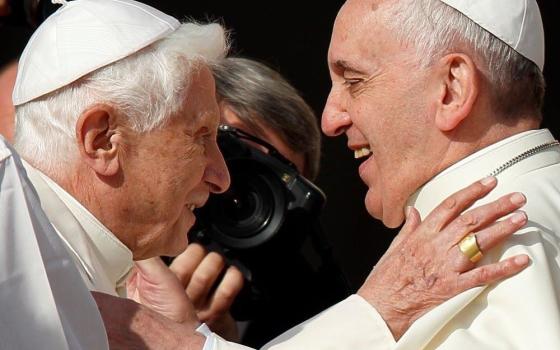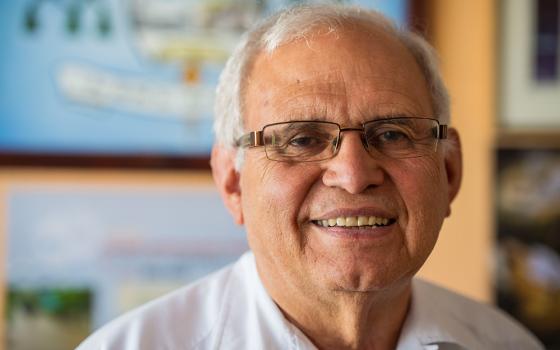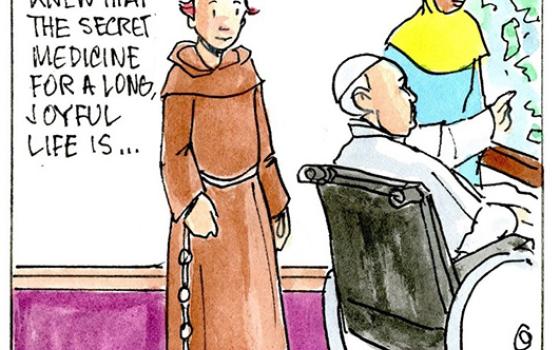ROME -- Benedictine abbots from around the world gathered in a monastery atop the Aventine Hill in Rome to discuss what has been happening in their monasteries, how they can work together and how they can reach out to the rest of the world.
The Congress of Abbots of the Benedictine Confederation of Monastic Communities brought 235 abbots, as well as representatives of Benedictine women's communities, to Rome's St. Anselm Abbey Sept. 17-25.
During the congress, the abbots re-elected German Abbot Notker Wolf to a four-year term as abbot primate.
The main talks at the congress focused on the viability of Benedictine monasteries, and on balancing the autonomy of Benedictine abbeys with a need for wider cooperation among them. But the abbots also participated in workshops on issues ranging from ecumenical and interreligious dialogue to the formation of candidates for monastic life.
Two facts framed much of the discussion: Benedictine abbeys generally are growing in Asia, Africa and South America; while abbeys in Europe, North America and Australia generally have a declining membership.
There are exceptions to the rule. Abbot Peter Novecosky of St. Peter's Abbey in Muenster, Saskatchewan, just welcomed six candidates to his community of 15 monks.
"For us, six is an unusually high number. I consider that God is blessing us," he said. "We lost five members to death in the last two years, so maybe they are sending replacements."
The abbot said the men, who range in age from 19 to 52, will have a six-month candidacy period and then move to a one-year novitiate before first vows.
"They feel a call from God. It's a response to an awareness of God in their life and wanting to do his will," the abbot said, adding that the candidates have told him they consider the Benedictine life a "tried and true way of spirituality."
Novecosky said the men do not seem to be conservative in any "extreme way," but they appreciate that members of St. Peter's Abbey wear their habits for the community prayer four times a day and for daily Mass. They sing the liturgies in English.
"So there is a nugget of truth that those (communities) that don't keep some of the traditional values and things are not as attractive," he said. "That doesn't mean, though, that you have to go back to things as they were before 1960 or 1950. You have to continue to adapt and make life livable."
One of the main speakers at the Benedictine abbots' congress was Cistercian Fr. Michael Casey, an expert on monastic spirituality from Tarrawarra Abbey in Australia.
Maintaining tradition while responding to changing needs is an inescapable part of life, both for individuals and for religious communities, he said. "The fact that we are alive means that we are continually influenced by our past, continually interacting with our present, and looking forward to the future. It's really just a matter of personal integrity, personal vitality that we do respect and allow our past to continue speaking to us."
Casey said he would object to labeling "conservative" the young people who are attracted to older forms of Catholic religious life, habits and liturgy.
"People are looking for a clear alternative to the way they were brought up, just as many of the more free-wheeling religious communities are reacting to the tight discipline of their own youth," he said.
"I sometimes doubt whether the new generation are as conservative as they are sometimes labeled," Casey said. "I think what has happened is that they've gone up to the attic, they've rummaged around and found all sorts of things which they think are good and exciting."
"What they are really doing," he said, "is rejecting what their parents thought was valuable, and they've discovered -- with a great sense of adventure -- a new way of doing things," including practices set aside by the previous generation.
"But there isn't this kind of grim return to the past," he said. "It's a very light and joyful discovery that here's something that's been laying, gathering dust for years and it still has a value for us."
To support the younger, growing monasteries in the developing world, Benedictine communities cooperate through the Alliance for International Monasticism to fund scholarships, provide instruction for leaders and novice masters and, sometimes, help with the material needs of the new communities.
The factors determining how a person hears a call to enter religious life and finds the support and conviction to follow that call can vary widely, said Benedictine Fr. William Skudlarek of St. John's Abbey in Collegeville, Minn.
The oldest of eight children raised on a farm in Minnesota, Skudlarek said he felt God was calling him to be a priest, but he also wanted to get away from farm work. His decision in 1951 to enter the minor seminary at Collegeville both pleased his parents and freed him from his chores.
The growing Benedictine communities today are in Africa, India, Vietnam and South America, he said.
"Are there socioeconomic factors at work there? I think so," he said. "I think God can also use socio-economic ways of attracting people to monastic life."



